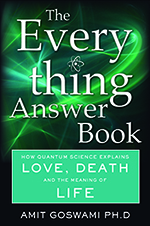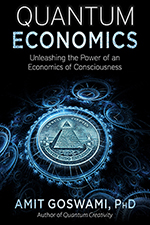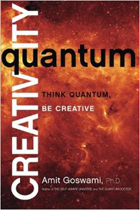Quantum Activism: Why Women are Naturals, but Men Can Thrive in It Too
By Amit Goswami, Ph. D.
Quantum physics has been around for almost a hundred years. But although much has been written about the revolutionary philosophical and worldview implications of this “new” physics, it is a fact that the majority of intellectuals of the world, particularly those belonging to academia, still hold on to the worldview of the “old” Newtonian physics.
I have been involved with propagating the quantum worldview, especially, the most paradigm shifting idea that it gives us, namely, that consciousness, not matter, is the ground of all being, for the last three decades. The result of my involvement, albeit promising, has been slow. Therefore, in desperation (who can blame me for wanting to see the worldview change while I am still alive!), a few years back with the help of a couple of friends, the filmmakers Ri Stuart and Renee Slade, I started a movement called quantum activism. The avowed manifesto of quantum activism is to spread the implications of the quantum worldview: explicitly, to inspire individuals to use quantum principles to transform themselves and the society.
Now, mind you, I myself have been a quantum activist for the last three decades. I have written books, attended a lot of conferences, given a lot of talks and workshops on the primacy of consciousness, and in my private life tried to walk the talk quite seriously. Two things stand out in my experience: one private, one public.
The public one first: by far the majority of attendees of the new science conferences and workshops tend to be women, mostly middle-aged women to boot. Now as far as my own talks and workshops are concerned, this is a little surprising. Why? Well the conventional image of middle-aged nonscientist women is supposed to be that they are scared of quantum physics. And yet, seventy to eighty percent of my audience is female!
The private finding is this: even with all my good intentions and lots of intellectual and meditative efforts, living up to the transforming principles of the quantum worldview has not been easy for me. Let me just honestly say that my experiments with learning to love unconditionally (in quantum activism we say “tangled hierarchically”; tangled hierarchy means a two way relationship of circular causality between two people) have been the most time-consuming ones in my life.
And now the explanations: non scientist women are a little scared of physics perhaps, but their fear is transcended as soon as they find out that the quantum worldview legitimizes consciousness, legitimizes feelings, legitimizes even the “energies” of love. Why? Because, I submit, some representation of the archetype of love is built into women as a brain circuit in the form of the maternity instinct.
At the outset, this may sound a little trite. But hear me out. In my book Creative Evolution I have argued that (Lamarckian) evolution gives us instincts in the form of brain circuits. Usually, these brain circuits are connected with negative emotions: lust, anger, jealousy, competitiveness, etc. and men and women both have them. Sadly, positive emotional brain circuits are relatively rare. There are a few: one is a circuit for altruism that many people (men and women) have; another is what more recently has been called God in the brain, a circuit in the midbrain which when activated gives you a spiritual experience, a God experience so to speak (I sometimes call this spot in the brain the new G-spot).
Now to the crux of this essay: women, and only women, have a third positive emotional brain circuit. This is the maternity circuit I mentioned above. Okay, it is not much activated until a woman becomes a mother. But motherhood does indeed come with a lot of unconditional love for the child, doesn’t it? Even men can vouch for it; they too have been nourished by the energies of love from their mothers while growing up.
Well, you will say, but is motherly love tangled hierarchical? Don’t mothers get to be the disciplinarians, which is impossible without simple hierarchy—one party dominating the other? In India, there is the myth of Yoshoda, child Krishna’s adoptive mother. Yoshoda has to “change diapers” and discipline her kid no doubt, but Krishna is God incarnate! And knowing that (from the many miracles the baby Krishna routinely performs), how can Yoshoda not be reverential to Krishna and defer to him on occasions as well? The myth is trying to tell mothers how to make the mother-child relationship tangled hierarchical: realize that your child is God. Indeed, in India (in the olden days), children until age 5 were regarded as God; they were treated with respect.
I think with or without the advantage of the myth, all mothers do that to a certain extent, that is, treat their child with respect. How can they not when holding their child they know is an immediate access to the energies of love, the heart chakra?
So I think, as mothers, all women begin a journey that can be called a journey toward the heart. The goal is to identify more with the heart—love—than with their brain—thinking!
“Objection!” you will say (if you have read any of my books), and, moreover, ask, “Doesn’t the brain give us self-identity because it has a tangled hierarchy built into it? Where is the tangled hierarchy of the heart, which is, after all, just a simple muscle?”
You are right. It is not the heart, per se. My latest research is showing that the immune system, a heart chakra organ, together with a couple of navel chakra organs, is the key here. And the tangled hierarchy exists not among these physical organs but among the vital blueprints of the organs (that Rupert Sheldrake calls morphogenetic fields). Indeed, there is now some data that shows that the immune system and its gastro-intestinal associates together may very well have some causal autonomy, the signature of a tangled hierarchy.
So women are a natural to explore tangled hierarchy and quantum activism, agreed? How about men? Can they ever succeed in developing a tangled hierarchical relation with another? My own experience is that, yes, they can, but it is time consuming. Why? Men have a natural tendency in our culture to suppress the heart.
But wait! Women do not have it so easy either. I said above that the morphogenetic fields of a couple of navel chakra organs are involved with the tangled hierarchy at the heart. Navel chakra is the site of the body ego, and men have it strong; this is what drives them toward power and simple hierarchy. And culturally, women are taught to suppress the naval chakra tendencies.
There you have it. Women have access to heart chakra love that gives them a curious interest in tangled hierarchy; but they suffer from a de-emphasis of the simple hierarchy of the ego chakra. Men suffer from a lack of appreciation of tangled hierarchy of gastro-intestinal-immunological organs, but they have plenty of access to the navel chakra simple hierarchy of the body ego.
We need both. Carl Jung was right. We have to balance body-ego—self respect—and love, which begins with respect for the other, in our behavior—animus and anima. And both women and men are capable of integrating the two, although it takes time.



